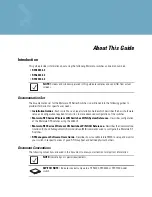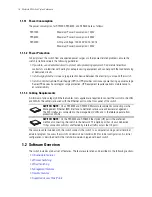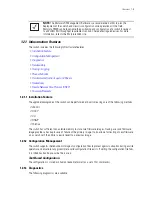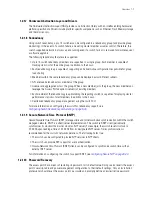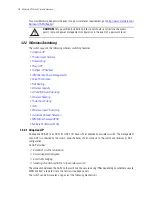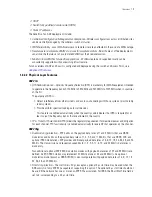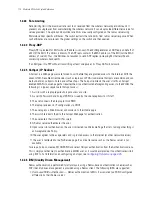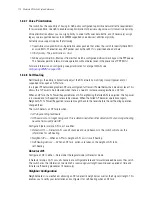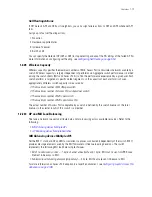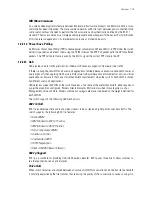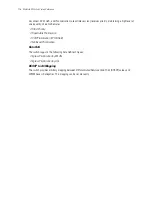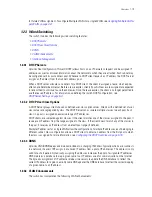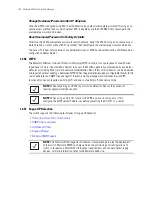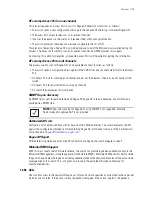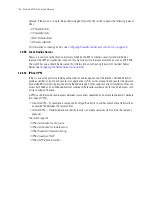
1-12
Motorola RF Switch Systen Reference
1.2.2.7 Voice Prioritization
The switch has the capability of having its QoS policy configured to prioritize network traffic requirements
for associated MUs. Use QoS to enable voice prioritization for devices using voice as its transmission priority.
Voice prioritization allows you to assign priority to voice traffic over data traffic, and (if necessary) assign
legacy voice supported devices (non WMM supported voice devices) additional priority.
Currently voice support implies the following:
•
Spectralink voice prioritization
- Spectralink sends packets that allow the switch to identify these MU's
as voice MU's. Thereafter, any UDP packet sent by these MU's is prioritized ahead of data.
•
Strict priority
- The prioritization is strict.
•
Multicast prioritization
- Multicast frames that match a configured multicast mask bypass the PSP queue.
This features permits intercom mode operation without delay (even in the presence of PSP MU's).
For more information on configuring voice prioritization for a target WLAN, see
Configuring WMM on page 4-65
.
1.2.2.8 Self Healing
Self Healing is the ability to dynamically adjust the RF network by modifying transmit power and/or
supported rates upon an AP failure.
In a typical RF network deployment, APs are configured for Transmit Power below their maximum level. This
allows the Tx Power to be increased when there is a need to increase coverage when an AP fails.
When an AP fails, the Tx Power/Supported rates of APs neighboring the failed AP are adjusted. The Tx power
is increased and/or Supported rates are decreased. When the failed AP becomes operational again,
Neighbor AP’s Tx Power/Supported rates are brought back to the levels before the self healing operation
changed them.
The switch detects an AP failure when:
• AP stops sending heartbeats.
• AP beacons are no longer being sent. This is determined when other detector APs are no longer hearing
beacons from a particular AP.
Configure 0 (Zero) or more APs to act as either:
•
Detector APs
— Detector APs scan all channels and send beacons to the switch which uses the
information for self-healing.
•
Neighbor APs
— When an AP fails, neighbor APs assist in self healing.
•
Self Healing Actions
— When an AP fails, actions are taken on the neighbor APs to do
self-healing.
Detector APs
Configure an AP in either – Data mode (the regular mode) or Detector mode.
In Detector mode, an AP scans all channels at a configurable rate and forwards received beacons the switch.
The switch uses the information to establish a
receive signal strength baseline
over a period of time and
initiates self-healing procedures (if necessary).
Neighbor Configuration
Neighbor detect is a mechanism allowing an AP to detect its neighbors as well as their signal strength. This
enables you to verify your installation and configure it for self-healing when an AP fails.
Содержание RFS Series
Страница 1: ...M Motorola RFS Series Wireless LAN Switches WiNG System Reference Guide ...
Страница 10: ...TOC 8 Motorola RF Switch System Reference Guide ...
Страница 56: ...2 8 Motorola RF Switch System Reference ...
Страница 334: ...5 52 Motorola RF Switch System Reference 2 Select the MU Status tab ...
Страница 510: ...7 32 Motorola RF Switch System Reference Guide ...
Страница 534: ...8 24 Motorola RF Switch System Reference Guide ...
Страница 570: ...C 14 Motorola RF Switch System Reference Guide ...
Страница 589: ......
Страница 590: ...MOTOROLA INC 1303 E ALGONQUIN ROAD SCHAUMBURG IL 60196 http www motorola com 72E 132942 01 Revision C December 2010 ...


